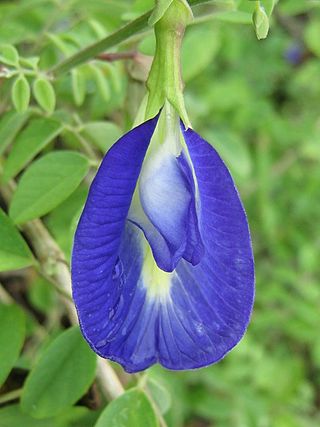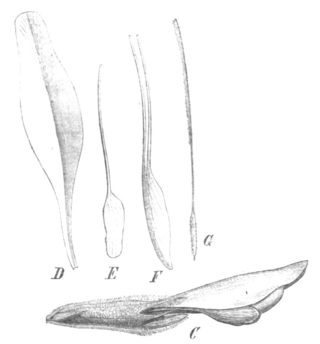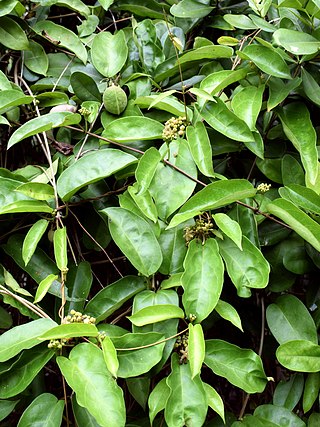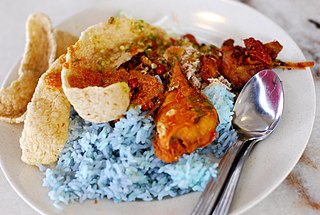
Indigofera tinctoria, also called true indigo, is a species of plant from the bean family that was one of the original sources of indigo dye.

Clitoria is a genus of mainly tropical and subtropical, insect-pollinated flowering pea vines.

Deguelin is a derivative of rotenone. Both are compounds classified as rotenoids of the flavonoid family and are naturally occurring insecticides. They can be produced by extraction from several plant species belonging to three genera of the legume family, Fabaceae: Lonchocarpus, Derris, or Tephrosia.
Pulot Tartal, pulut tai tai or pulut tekan is a Nyonya glutinous rice dessert. Originating from Melaka, Malaysia, it is also commonly served in other states in the country as well.

Clitoria ternatea, commonly known as Asian pigeonwings, bluebellvine, blue pea, butterfly pea, cordofan pea or Darwin pea is a plant species belonging to the family Fabaceae, endemic and native to the Indonesian island of Ternate.

Eriodictyol is a bitter-masking flavanone, a flavonoid extracted from yerba santa, a plant native to North America. Eriodictyol is one of the four flavanones identified in this plant as having taste-modifying properties, the other three being homoeriodictyol, its sodium salt, and sterubin.

Abronia villosa is a species of sand-verbena known by the common names desert sand-verbena and chaparral sand-verbena. It is in the four o'clock plant family (Nyctaginaceae). It is native to sandy areas in the deserts of the southwestern United States and northern Mexico, associated with creosote-bush and coastal-sage scrub habitats.

Tephrosin is rotenoid. It is a natural fish poison found in the leaves and seeds of Tephrosia purpurea and T. vogelii.

Barbieria is a genus of flowering plants in the legume family, Fabaceae.

Barbigerone is one of a few pyranoisoflavones among several groups of isoflavones. It was first isolated from the seed of a leguminous plant Tephrosia barbigera; hence the name "barbigerone". Members of the genus Millettia are now known to be rich in barbigerone, including M. dielsiena, M. ferruginea, M. usaramensis, and M. pachycarpa. It has also been isolated from the medicinal plant Sarcolobus globosus. Barbigerone from S. globosus is validated to have significant antioxidant property. Barbigerone exhibits profound antiplasmodial activity against the malarial parasite Plasmodium falciparum. It is also demonstrated that it has anti-cancer potential as it causes apoptosis of murine lung-cancer cells.

Sarcolobus globosus is a twining shrub native to tropical regions of Asia including India, China, Thailand, Malaysia, Myanmar-Burma, the Philippines and Indonesia.

Rotenoids are naturally occurring substances containing a cis-fused tetrahydrochromeno[3,4-b]chromene nucleus. Many have insecticidal activity, such as the prototypical member of the family, rotenone. Rotenoids are related to the isoflavones.

Derris trifoliata is a plant species in the genus Derris, Family - Leguminosae It is known as "Karanjvel" in Marathi - local language of Maharashtra, India.
Lonchocarpus salvadorensis, the Sangre de Chucho, is a plant species in the genus Lonchocarpus.

Nasi kerabu is a Malaysian cuisine rice dish, a type of nasi ulam, in which blue-colored rice is eaten with dried fish or fried chicken, crackers, pickles and other salads. The blue color of the rice comes from the petals of Clitoria ternatea (butterfly-pea) flowers (bunga telang), which are used as a natural food coloring in cooking it. The rice can also be cooked with plain white rice or rice cooked using turmeric. It is often eaten with solok lada and is also eaten with fried keropok.

Clitoria mariana, known by the common names butterfly pea and Atlantic pigeon wings, is a perennial herbaceous plant in the pea family, Fabaceae. The plant is native to the United States.

Butterfly pea flower tea, commonly known as blue tea, is a caffeine-free herbal tea, or tisane, beverage made from a decoction or infusion of the flower petals or even whole flower of the Clitoria ternatea plant. Clitoria ternatea is also known as butterfly pea, blue pea, Aprajita, Cordofan pea, Blue Tea Flowers or Asian pigeonwings.

Clitoria falcata is a plant of the genus Clitoria native to South and Central America.

Clitoria guianensis is a plant of the genus Clitoria native to Brazil.
Pilea fairchildiana, which was previously known as Sarcopilea domingensis, is a succulent plant endemic to the Constanza Mountains of the Dominican Republic. It was thought to be under a monospecific genus (Sarcopilea), but with new phylogenetic information is now placed under the genus Pilea.


















